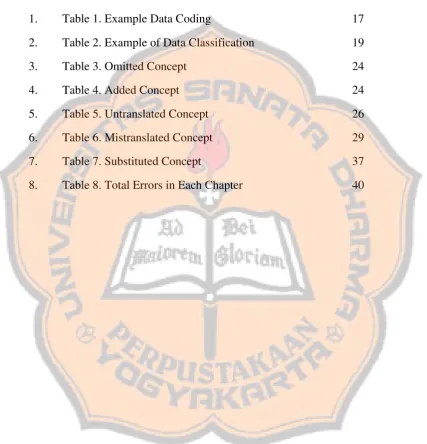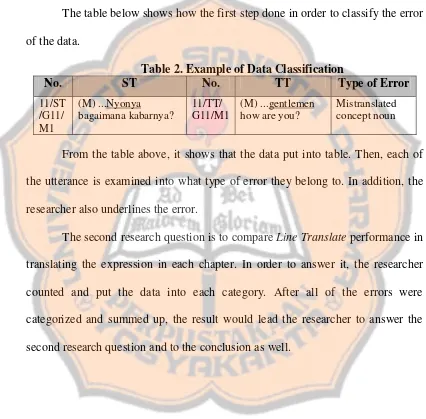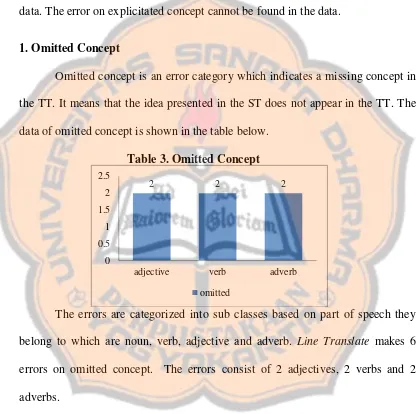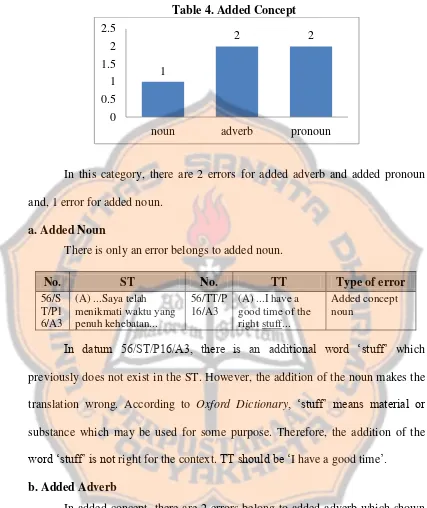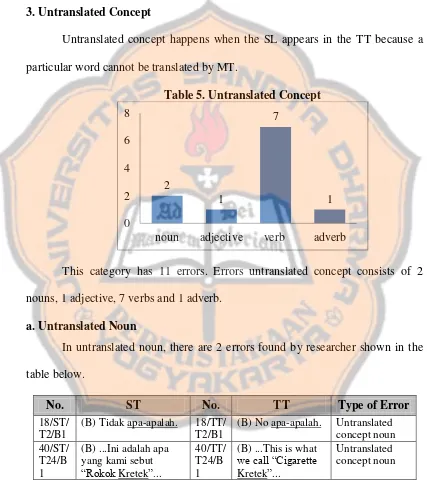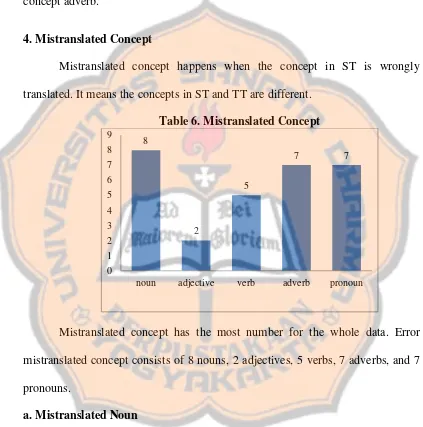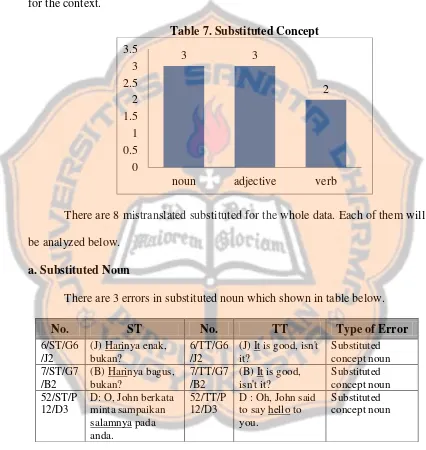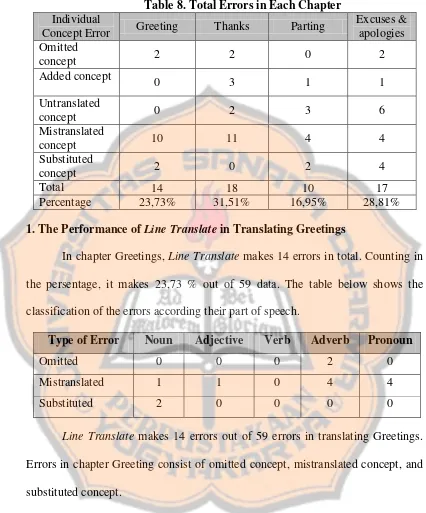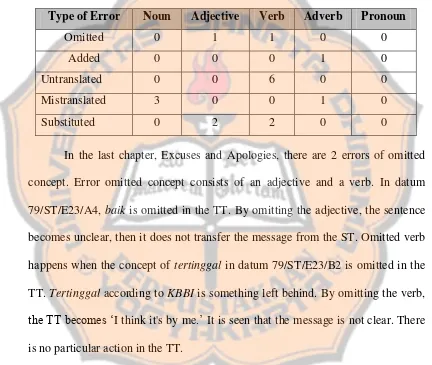ERROR ANALYSIS OF
LINE TRANSLATE
’S PERFORMANCE
IN TRANSLATING DAILY BASIC CONVERSATION IN
PERCAKAPAN BAHASA INGGRIS SEHARI-HARI
AN UNDERGRADUATE THESIS
Presented as Partial Fulfillment of the Requirements
for Degree of Sarjana Sastra
in English Letters
By
M.Y. CHRISTY GHEDA PATI TIALA
Student Number: 144214045
DEPARTMENT OF ENGLISH LETTERS
FACULTY OF LETTERS
UNIVERSITAS SANATA DHARMA
YOGYAKARTA
▸ Baca selengkapnya: percakapan bahasa makassar sehari-hari
(2)ii
ERROR ANALYSIS OF
LINE TRANSLATE
’
S PERFORMANCE
IN TRANSLATING DAILY BASIC CONVERSATION IN
PERCAKAPAN BAHASA INGGRIS SEHARI-HARI
AN UNDERGRADUATE THESIS
Presented as Partial Fulfillment of the Requirements
for Degree of Sarjana Sastra
in English Letters
By
M.Y. CHRISTY GHEDA PATI TIALA
Student Number: 144214045
DEPARTMENT OF ENGLISH LETTERS
FACULTY OF LETTERS
UNIVERSITAS SANATA DHARMA
YOGYAKARTA
vii
Many plans are in a man
’
s heart, but the
purpose of the Lord will prevail.
viii
ix
ACKNOWLEDGEMENTS
Firstly, I would like to express my gratitude to God for his blessing and
companion in every journey of my life, and finally I can write my
acknowledgements.
Secondly, I want to thank my thesis advisor, Harris Hermansyah Setiajid,
M.Hum for helping me from the very beginning of this thesis writing. My thanks
go to my co-advisor, Anna Fitriati, S.Pd., M.Hum. for giving me valuable
suggestions to improve my thesis. Also, I would like to express my gratitude
towards all lecturers of English Letters Department for giving me inspiration
during my 4 years of study.
I want to thank my father, Dami Tiala, for his hard work to support my
study. My gratitude towards my mother, Ritta Deske, who always has her faith
and understanding in every single path I took to finish my undergraduate thesis.
In addition, I would like to mention some names who contributed during
this process of writing. I want to give my thanks to Lintang, Vincent, Titis,
Rangga, Philip, Flo, Karisa and Mira who helped me during my downs. I want to
thank Acit, Ayu, Festy, Shella, Didi and the others who belong to Kelas B kenyil
group who supported me to finish my thesis. Also, I want to thank Wira and Arsa.
Thank you for the every laughter, lesson and moment we shared.
Last but not least, I want to thank everyone that cannot be mentioned here
who helped me in their capacity to finish my undergraduate thesis, God bless you.
x
TABLE OF CONTENTS
TITLE PAGE... ii
APPROVAL PAGE... iii
ACCEPTANCE PAGE... iv
STATEMENT OF ORIGINALITY... v
PUBLIKASI KARYA ILMIAH... vi
MOTTO PAGE... vii
DEDICATION PAGE... viii
ACKNOWLEDGEMENTS... ix
TABLE OF CONTENTS... x
LIST OF ABBREVIATIONS... xii
LIST OF TABLES... xiii
ABSTRACT... xiv
ABSTRAK... xv
CHAPTER I: INTRODUCTION... 1
A. Background of Study... 1
B. Problem of Formulation... 3
C. Objectives of the Study... 4
D. Definitions of Terms... 4
CHAPTER II: REVIEW OF LITERATURE... 5
A. Review of Related Studies... 5
1. Kurnianto
’
s thesis... 5
2. Ariany
’
s thesis... 6
3. Veronika
’
s thesis... 7
B. Review of Related Theories... 8
1. Translation... 8
2. Machine Translation... 9
3. Koponen
’
s Error Classification in Assessing Machine
Translation Quality... 10
C. Theoretical Framework... 13
CHAPTER III: METHODOLOGY... 14
A. Areas of Research... 14
B. Object of the Study... 15
C. Method of the Study... 15
D. Research Procedure... 16
1. Types of Data... 16
2. Data Collection... 17
3. Population and Sample... 18
xi
CHAPTER IV: ANALYSIS RESULT AND DISCUSSION... 20
A. The Errors Found in the Translation of Indonesian Daily
Conversation... 20
1. Omitted Concept...21
2. Added Concept... 23
3. Untranslated Concept... 26
4. Mistranslated Concept... 29
5. Substituted Concept... 37
B. Line Translate performance in Translating Expression in
Particular Chapters... 39
1. The Performance of Line Translate in Translating Greetings... 40
2. The Performance of Line Translate in Translating Thanks... 42
3. The Performance of Line Translate in Translating Parting... 45
4. The Performance of Line Translate in Translating Excuses
and Apologies... 47
CHAPTER V: CONCLUSION... 50
BIBLIOGRAPHY... 52
APPENDICES... 54
Appendix 1... 54
Appendix 2... 78
xii
LIST OF ABBREVIATIONS
E
: Excuses and Apologies
G
: Greetings
MT
: Machine Translation
OA
: Official Account
P
: Parting
SL
: Source Language
ST
: Source Text
T
: Thanks
xiii
LIST OF TABLES
No.
Table
Page
1.
Table 1. Example Data Coding
17
2.
Table 2. Example of Data Classification
19
3.
Table 3. Omitted Concept
24
4.
Table 4. Added Concept
24
5.
Table 5. Untranslated Concept
26
6.
Table 6. Mistranslated Concept
29
7.
Table 7. Substituted Concept
37
xiv
ABSTRACT
TIALA, M.Y. CHRISTY GHEDA PATI.
(2018). Error Analysis of Line
Translate
’
s Performance in Translating Daily Basic Conversation in
Percakapan Bahasa Inggris Sehari-hari
.
Yogyakarta: Department of English
Letters, Faculty of Letters, Sanata Dharma University.
Machine Translation (MT) is one of the proofs for the rising of
technology. MT helps humans to translate a language to another language. One of
the advantages for using MT is that time is faster. However, the result of the
translation is not perfect. The translation of MT still need to be post-edited. In
2015, Line as one of the social media established a MT feature to translate, ID-EN
Translator. ID-EN Translator can translate Indonesian to English and vice versa.
As already stated that the product of MT
’
s translation is not perfect, the researcher
is interested to study the error
ID-EN Translator might make. In addition, the
research chooses a book entitled
Percakapan Bahasa Inggris Sehari-hari
as the
data for this study.
In this study, the researcher analyzes two problems. The first is to find and
classify the errors in the translation of Indonesian daily conversation by
Line
Translate. The second one is to see
Line Translate performance in translating
expression in particular chapters.
In this research, the researcher uses library method in order to study the
theories applied and the related studies. Furthermore, explicatory method is also
used in order to analyze the data.
xv
ABSTRAK
TIALA, M.Y. CHRISTY GHEDA PATI. (2018). Error Analysis of Line
Translate
’
s Performance in Translating Daily Basic Conversation in
Percakapan Bahasa Inggris Sehari-hari
.
Yogyakarta: Program Studi Sastra
Inggris, Fakultas Sastra, Universitas Sanata Dharma.
Mesin penerjemah merupakan salah satu hasil dari perkembangan
teknologi. Mesin penerjemah membantu manusia untuk menerjemahkan suatu
bahasa ke bahasa lain. Salah satu keuntungan dalam penggunaan mesin
penerjemah adalah waktu yang singkat. Walau demikian, terjemahan dari mesin
penerjemah dinyatakan tidak sempurna, perlu adanya pengoreksian ulang. Pada
tahun 2015, Line sebagai salah satu media sosial meluncurkan
ID-EN Translator
sebagai salah satu fitur mesin penerjemah untuk menerjemahkan.
ID-EN
Translator dapat menerjemahkan Bahasa Indonesia ke Bahasa Inggris dan
sebaliknya. Namun, seperti disebutkan di atas bahwa hasil terjemahan mesin
penerjemah tidak sempurna, maka peneliti tertarik untuk mencari kesalahan yang
dibuat
ID-EN Translator. Peneliti memilih buku berjudul
Percakapan Bahasa
Inggris Sehari-hari sebagai data untuk penelitian ini.
Di dalam studi ini, penulis menganalisis dua masalah. Yang pertama
adalah menemukan kesalahan di dalam hasil terjemahan Line Translate dan yang
kedua adalah melihat kinerja
Line Translate dalam menerjemahkan ekspresi
dalam setiap bab yang telah dipilih dalam penelitian ini.
Peneliti menggunakan metode pustaka dalam penulisan teori dan
penelitian yang berkaitan dengan penelitian ini. Selanjutnya, peneliti juga
menggunakan metode explicatory untuk menganalisa data.
1
CHAPTER I
INTRODUCTION
A. Background of The Study
Language and human beings cannot be separated.
Pei states that “language
is an expression of huma
n activity” (1984:26). It means people always use
language to prove their existence. As people live in different countries, people
also speak in different languages. When people communicate in different
languages, they cannot understand each other. Therefore, people translate to
produce translation to overcome this situation.
According to Nida and Taber
, “
translating consists of reproducing in the
receptor language the closest natural equivalence of the source language message,
first in terms of meaning and secondly in terms of style” (1982
:12). It means that
translating is a process which changes the Source Language (SL) into the Target
Language (TL). The process must change the language into another language
which the Target Text TT) has the same meaning and style from the Source Text
(ST).
In this modern era, technology is one of the needs of human beings. Every
aspect of human beings can be related to technology. One of the results of
technology is social media. Social media help people to communicate through the
internet. There are various forms of social media equipped with their own
and also
Line. Each social media provides their own characteristics to help the
users communicate easily. Line as of the social media is chosen for this study.
“
Line was established in 2011 in Japan and 2013 in Indonesia and until
now it has more than 169 million users
”
(LINE - Statistics & Facts). The users are
widely spread around the world.
Line provides the users with various features,
such as
chat room to have a written conversation with other users, home to post
update news, Line free call to make a phone call with another user and also Line
Translate. Line Translate was established in 2015. The form of Line Translate is
an Official Account (OA). OA is a public account that can be accessed by all Line
users. OA is provided by
Line itself or a corporation/brand that agrees to
cooperate with
Line. For the users who want to make the use of it, they need to
add the OA of Line Translate
into their friends‟ list. After that, they can translate
the text in the chat room. This study chooses
ID-EN Translator as the subject of
the study. ID-EN Translator is an OA to translate Indonesian to English and vice
versa. In addition, from now on,
ID-EN Translator will be stated as
Line
Translate in this study.
This undergraduate thesis discusses the performance of ID-EN Translator
or
Line Translate as a Machine Translation (MT). The researcher studies the
performance of Line Translate in translating Indonesian daily basic conversation.
There are two reasons for choosing daily basic conversation as the subject. First,
daily basic conversation is important considering that
it is used in everyday‟s life.
Second, it consists of simple phrases and sentences that commonly used. In
One of the ST is ada baik jualah, terima kasih which is translated by Line
Translate
into „there are both sell, thank you.‟
From the translation, it is clearly
seen that the TT has different meaning from the ST. In this case, the word jualah
comes from the word
juga and particle -lah
which means „also‟ or „too
.
‟
However,
Line Translate understands it as
jual-lah
which means „
to sell.
‟
Therefore, the translation becomes
„
sell
.‟
The translation should be
„
quite well,
thank you.
‟
From this case, it shows that the message transferred is different.
Therefore, the researcher is interested to study the performance of Line Translate
by studying errors found in the translation of Indonesian daily basic conversation.
This research is expected to help the readers, especially students in Sanata
Dharma University to see the performance of
Line Translate as a MT in
translating daily basic conversation from Indonesian to English. In addition, this
study hopefully will be one of the consideration to improve the performance of
Line Translate.
B. Problem Formulation
There are two research questions in this undergraduate thesis which would
be analyzed. They are formulated into two questions as follow:
1. What errors are found in the English translation of Indonesian daily
conversation done by Line Translate
based on Koponen‟s category?
C. Objectives of The Study
There are two objectives of this study. First is to find out the errors in the
translation of Indonesian daily conversation using
Koponen’s Assessing Machine
Translation Quality with Error Analysis and second is to analyze the performance
of Line Translate in translating the expression in particular chapters of Indonesian
daily basic conversation.
D. Definitions of Terms
Line
is
a Japan-based, cross-platform mobile messenger app with 217
million monthly active users worldwide. The service is operated by Line
Corporation (LINE - Statistics & Facts).
Machine Translation
is the now traditional and standard name for
computerized system responsible for the production of translations from one
natural language into another, with or without human assistance (Hutchins and
Somers, 1992:3)
Error Analysis in Machine Translation is the analysis with a view to
identify different error types which focuses on mismatches of semantic
5
CHAPTER II
REVIEW OF LITERATURE
In this chapter, the researcher discusses similar topics done by other
researchers and also the theories which are applied in this study. The related
studies are taken from Kurnianto's, Ariany's and Veronika's thesis. Each study is
discussed and elaborated to see the main focus and the similarities to this research.
In addition, to avoid the same topic, the researcher also reviews the study's
distinction between the related studies and the present undergraduate thesis. The
theories are also reviewed and discussed in order to understand this research.
A. Review of Related Studies
1. Kurnianto's thesis "Google Translate Assesment with Error Analysis: An
Attempt to Reduce Error"
This undergraduate thesis done by Kurni
anto discusses Google Translate’
s
assessment of error analysis and the attempts to reduce the errors. The writer uses
three source texts. They are the ownership agreement document, a national
geography's article, and iPad user guide.
This study has two research question. The first one is what errors found in
the source text translated by Google Translate and the second is what suggestions
proposed to reduce errors in using Google Translate. In order to answer the
In addition, the writer uses Farrus' solution in optimizing the use of machine
translation.
This study shows that Google Translate makes 206 errors. The writer also
discovers that the most errors are mistranslated concepts which are 136 errors.
Kurnianto also suggests Google Translate to reduce errors, firstly translated in
isolated form covering type in lower case, functions categorization, search the
appropriate equivalence form the list of meaning, and type the phrase without
"enter", secondly text edition, and the combination of some methods.
The research done by Kurnianto discusses Google Translate while this
present undergraduate thesis chooses Line Translate as its subject of the study.
2. Ariany's thesis "Bing Translator's and Google Translate's Performance in
Translating English Literary and Academic Text into Indonesian"
In this undergraduate thesis, Ariany discusses Bing Translator and Google
Translate performance. There are two source texts chosen, english literary and
academic text. In this study, Ariany studies two objectives, the first is to find out
the errors in the translation of literary and academic text using Bing Translator
and Google Translate, and the second is to measure Google Translate and Bing
Translator performance in translating the literary and academic texts. Ariany uses
Koponen's theory to conduct this research.
This study shows that Google Translate makes fewer errors than Bing
Translator. It also shows that Google Translate has better performance than Bing
3. Veronika's thesis "Instagram Translate's and Human Translation's
Performance in Translating the Captions in @Basukibtp Instagram
Account"
This undergraduate thesis discusses the comparison between Instagram
Translate and human translator. The object of the research is Basuki Tjahja
Purnama's instagram account.
This research focuses on two objectives. The first one is to find out the
errors of English translation done by Instagram Translate and human translator
and the second is to compare the performance of Instagram Translate and human
translator. The researcher uses Koponen's theory which divides the errors into six
subclasses to find and classify the errors.
This study shows that in the final result there are 54 errors done by
Instagram Translate meanwhile human translator makes 6 errors. After having the
results, it can be said that the performance of human translator is better than
Instagram Translate.
This present undergraduate thesis is different from Veronika's on its
subject. Veronika puts the comparison between Instagram Translate and human
translator as the focus of this research while the present researcher studies on Line
B. Review of Related Theories
1. Theories of Translation
Bell states, "translation is the expression in another language (or target
language) of what has been expressed in another, source language, preserving
semantic and stylistic equivalence" (1991:5). It means translation is a replacement
of language to another which tries to maintain the same impression from the ST
and TT. Semantic equivalence focuses on sending the same message and stylistic
equivalence focuses on sending the same sense between ST and TT.
For example is a proverb bagai air di atas daun alas, it can be translated
into both ‘
l
ike water on taro leaves’ or ‘
p
eople who don’t have principle.’ The
first translation tries to maintain the style of ST, meanwhile the second translation
translate the meaning directly. Therefore, the first one is considered into stylistic
and the second is semantic equivalence.
He also adds that, "translation is the replacement of a representation of a
text in one language by a representation of an equivalent text in a second
language" (1991:6). Here, Bell emphasizes again the importance of presenting the
same idea in the TT.
This statement is also supported by Nida and Taber. They state that,
"translation consists in reproducing in the receptor language the closest natural
equivalent of the source language, first in terms of meaning and secondly in terms
of style
”
(1974:12). In addition, Nida and Taber also state that transferring
meaning is a priority in terms of translation (1974:13). Here, translation puts the
translation is expected to maintain or keep the style of the text without changing
the meaning.
From those experts, it can be concluded that translation is a process of
changing a language (SL) into another language (TL) that gives the same sense
considering the meaning and style.
2. Machine Translation
According to Hutchin and Somers, "The term Machine Translation (MT)
is the now traditional and standard name for computerized system responsible for
the production of translations from one natural language into another, with or
without human assistance" (1992:3). It means that the term MT is related to
artificial intelligence that helps human to produce a translation.
In MT characteristics, Hutchin and Somers also state,
Translations produced by MT systems are inadequate. The MT
systems cannot make good translation result which is equivalent in
terms of semantic and stylistic. He adds that machine translation is not
possible to produce a good translation. Machine translation merely
stops in a phase of ‘raw translation' which still
need revising or
post-editing (Hutchin and Somers 1992:3).
It means that the translation produced by MT should be examined or
post-edited. It happens because MT is only an artificial intelligence which its capability
has limitation. It is also uncertain that MT can produce a perfect translation
considering the meaning and style. Therefore, if MT is assumed cannot make a
perfect translation, it can be studied further to the errors MT makes.
In addition, Koponen states that "Machine translation assessment has
(2010:1). It means the assessment focuses on how MT can accurately and fluent
transfer the message. She also adds "Quality assessment involves various aspect,
such as accuracy (fidelity), fluency and fitness for purpose, and different aspects
have been deemed important for every situation" (2010:1).
From those experts, it can be said that MT is a system to translate
language from ST into TT which still need to be post-edited. MT is considered not
able yet to produce a good translation considering its meaning and style.
3. Koponen's Error Classification in Assessing Machine Translation Quality
As stated above that MT is still considered not able to produce a perfect
translation, but it can be traced to what errors might MT make. Therefore,
Koponen in her journal,
Assessing Machine Translation Quality with Error
Analysis (2010), proposes the idea to assess the quality of MT's work using errors
analysis.
Koponen divides the errors into two big classes, first is mismatches
between source and target concepts and second is mismatches in relation between
concepts. The concept meant by Koponen is the idea presented in the ST and TT.
Error in the first category is represented by the content words while the error in
the second category represented by function words, inflection, and word order.
Error between source and target text concepts is divided into six
subclasses. They are omitted concept, added concept, untranslated concept,
mistranslated concept, substituted concept, and explicitated concept. The second
class is errors on relation between concepts. The second class is divided into eight
relation, untranslated participant; and relation, mistranslated participant; and
relation. The meaning of each error is provided by Koponen while the elaboration
and examples are provided by the researcher and Koponen.
a. Mismatches between source and target concepts (Koponen, 2010: 4-5)
i. Omitted concept happens when ST concept is not conveyed by the TT.
It means the concept that appears in the ST is not presented in the TT.
For example, when the ST is
Anda ada pensil lainnya? the TT is
‘
You've got a pencil?
’
The concept of lainnya is omitted in the TT.
ii. Added concept happens when TT concept that is not present in the ST.
It means that there is an additional concept in the TT which previously
is not present in the ST. For example,
Saya akan telepon lagi nanti is
translated into
‘I'll call you later.’
It can be seen that
‘
you
’
which
appears in TT does not exist in ST before.
iii. Untranslated concept occurs when SL words that appear in TT. It
means that the word in ST is not possible to be translated, therefore the
word appears again in the TT. For example, Tidak apa-apalah
in the
ST is translated into
‘No apa
-
apalah.’
The word
apa-apalah is
considered into untranslated concept because they appear in both ST
and TT.
iv. Mistranslated concept exists when a TT concept has the wrong meaning
for the context. It means that the TT has the wrong meaning. It can
happen because a word can have more than one meaning. For example,
are you?
’
Nyonya means a woman who is married already, but it is
translated into
‘gentleman’ which
is an address to a man.
v. Substituted concept happens when TT is not a direct lexical equivalent
for ST concept but it can be considered as a valid replacement for the
context. For example, O, John berkata minta sampaikan salamnya pada
anda in ST is translated into
‘Oh, John said to say hello to you.’
In this
case,
salamnya is not considered equivalence for
‘
hello.
’
However, in
this context
‘
hello
’
is considered as a valid replacement of salam in the
ST.
vi. Explicitated concept occurs when TT concept explicitly states
information left implicit without adding information. It means there is
an additional concept in TT which is not explicitly stated in ST. For
example on Koponen's research, there is an addition of the word
ohjelma
which means ‘a
program.
’
Ohjelma is added to
‘
Norton
Antvirus
’
.
b. Mismatches in relations between concepts
i. Omitted participant: ST relation not conveyed by the TT due to an
omitted head or dependant
ii. Omitted relation: ST relation not conveyed by the TT due to
morphosyntactic errors that prevent parsing the relation although both
concepts are present in the TT.
iii. Added participant: TT relation not present in ST introducing an added
iv. Added relation: TT relation not present in ST arises due to
morpho-syntactic errors.
v. Mistaken participant: Head or dependant of the relation different in ST
and TT, not the same entity.
vi. Mistaken relation: Relation between two concepts different in ST and
TT, changed role.
vii.Substituted participant: Head or dependant of the relation different in
ST and TT, same entity.
viii.Substituted relation:Relation between two concepts different in ST and
TT, same semantic roles.
C. Theoretical Framework
The theories of translation according to Bell and Nida and Taber are used
to give understanding about the meaning of translation. Then, the theory of MT by
Hutchin and Somers is used to study
Line Translate as the subject of this study.
After knowing the definitions,
Koponen’s
theory of
Assessing Machine
Translation Quality with Error Analysis is used to identify the errors done by Line
Translate. By identifying the errors, the first research question in this study is
answered. Then, the error categorization is used to answer the second research
question,
Line Translate
’s performance in
translating expression in particular
chapters. By answering the first and second research question, the researcher is
14
CHAPTER III
METHODOLOGY
This chapter presents the methodology used in this undergraduate thesis.
There are four parts discussed in this chapter. They are area of research, object of
the study, method of the study, and research procedure. The last part, research
procedure discusses types of the data, data collection, population and sample, and
data analysis.
A. Areas of Research
The area of this research is translation and technology. According to
William and Chesterman, “
there are three range topics to be discussed in
translation and technology, they are evaluating software, software localization,
and effects of technology
”
(2002:14). This research takes
ID-EN Translator
or
stated as Line Translate as its subject of the study. It focuses on the translation of
Indonesian daily basic conversation done by
Line Translate. In addition, it also
evaluates
Line Translate
’s performance in translating
expression in particular
chapters.
William and Chesterman also add that
, “
in evaluating software, language
engineering is producing more and more software for machine translation and
computer-
aided translation”
(2002:14). Therefore, this study is included into
translation and technology on evaluating software because this research studies
The researcher's goal is to find out the mismatches or errors in translating
daily basic conversation. After finding the errors, the researcher is able to measure
the performance of Line Translate.
B. Object of the Study
The object of this study is the English translation of Indonesian daily
conversation. The data are taken from a book entitled Percakapan Bahasa Inggris
Sehari-hari by S.F.Habeyb. It was published by PT Bhuana Ilmu Populer,
Kelompok Gramedia, Jakarta. The data population consists of 22 chapters of
expression. However, the researcher only takes four chapters as the data sample.
They are Greeting, Parting, Thanks, and Excuses and Apologies. There are two
reasons for choosing only 4 chapters out of 22. First, the 4 chapters are considered
the most important expression and the second, the 4 chapters consists of
expression that is commonly used in every day’s life.
The formation of the data is a text conversation between 2 people. The
data then are translated by
Line Translate. The translations are divided into
sentences and classified into the error categories they belong to.
C. Method of The Study
In this study, the researcher uses library research method in writing the
chapter of literature and theories review. According to George, "library method
involves identifying and locating sources that provide factual information or
other research method at some point" (2008:6). Library method is used to study
related theories and study.
In addition, the researcher also uses explicatory method. George states,
"explicatory method entails a careful, close and focused examination of a single
major text, or of evidence surrounding a single complex event, in an attempt to
understand one or more aspects of it" (2008:6). Explicatory method is used to
identify and also analyze the errors in the English translation of Indonesian daily
basic conversation closely and carefully.
D. Research Procedure
1. Types of Data
The data collected in this undergraduate thesis are taken from the ST and
the TT. The ST is taken from the conversation in a book entitled
Percakapan
Bahasa Inggris Sehari-hari by S.F.Habeyb published by PT Bhuana Ilmu
Populer, Kelompok Gramedia, Jakarta. The TT is taken from the translation done
by
Line Translate. The book has been printed for 30 times, and the last one was
on September 2016.
There are four chapters taken as the data. They are Greetings, Thanks,
Parting, and Excuses and Apologies. There are 16 conversations and 71
expressions in Greetings, 24 conversations and 63 expressions in Thanks, 16
conversations and 75 expressions in Parting, and 31 conversations and 77
conversation and 286 expression for the whole data. The researcher translated the
data/ ST into TT using Line Translate on 25 June 2018.
2. Data Collection
The researcher would mention the steps taken in order to collect the data.
First, the researcher chose a text to be put into the study. It was Indonesian daily
conversation. Indonesian daily conversation was chosen by the researcher because
it was considered as the most important and also the simplest expression which
commonly used by the Line users.
Second, the researcher chose 4 chapters of the expression which are
Greetings, Thanks, Parting, and Excuses and Apologies. The researcher counted
on how many expressions in each of the chapter. Then, the researcher translated
the expression using Line Translate and put the data in the table as follows:
Table 1. Example Data Coding
No.
ST
No.
TT
Smith do the talking.
36/ST/
T20/H1
(H) Halo. Ini Helen Jones.
Boleh saya bicara dengan
saudara perempuan anda?
The code can be read as follows:
36
: The number of the data
ST
: Source Text
TT
: Target Text
T20
: Thanks (one of the chapters) conversation number 20
J
: James (stands for the name in the conversation)
Then, the researcher classified the errors according the categorization by
Koponen. One utterance might have more than one error or not have any error at
all. Then, the researcher put the data into the table.
3. Population and Sample
The population of the ST in this research are 22 chapters of daily
conversation. The sample of this research are 4 chapters (Greeting, Thanks,
Parting, and Excuses and Apologies). From the sample, there are 87 conversations
and 286 expressions. It consists of 16 conversations in Greetings, 24
conversations in Thanks, 16 conversation in Parting, and 31 conversations in
Excuses and Apologies. Then, the English translation of the 87 conversations are
obtained as the data population.
4. Data Analysis
There were two steps used in order to answer the research questions. First
was to find the error done by
Line Translate. The error category based on
Koponen's journal is divided into two big classes. They are mismatches between
source and target concept and mismatches in relation between concepts.
Mismatches between source and target concept consists of omitted concept, added
concept, untranslated concept, mistranslated concept, substituted concept, and
explicitated concept. Meanwhile, mismatches in relation between concepts
consists of omitted participant, omitted relation, added participant, added relation,
mistaken participant, mistaken relation, substituted participant, and substituted
The focus of this research is the first category of the error, mismatches
between source and target concepts. The reason for choosing only the first class is
the category is suitable to measure the performance of Line Translate. Therefore,
the next researcher can put the second category into the research.
The table below shows how the first step done in order to classify the error
of the data.
Table 2. Example of Data Classification
No.
ST
No.
TT
Type of Error
11/ST /G11/ M1
(M) ...Nyonya bagaimana kabarnya?
11/TT/ G11/M1
(M) ...gentlemen how are you?
Mistranslated concept noun
From the table above, it shows that the data put into table. Then, each of
the utterance is examined into what type of error they belong to. In addition, the
researcher also underlines the error.
The second research question is to compare Line Translate performance in
translating the expression in each chapter. In order to answer it, the researcher
counted and put the data into each category. After all of the errors were
categorized and summed up, the result would lead the researcher to answer the
20
CHAPTER IV
ANALYSIS RESULT AND DISCUSSION
This chapter discusses the analysis of the data which provides answers for
the research questions. The first analysis discusses about the errors classification
based on Koponen‟s category and the second analysis discusses
about the
performance of Line Translate in translating the expression in particular chapters.
Thus, the discussions bring result to Line Translate
‟s
performance.
A. The Errors Found in the Translation of Indonesian Daily Conversation
The first discussion in this analysis is to answer the first research question
which is to find the errors in Indonesian daily conversation. As mentioned in the
previous chapter, the daily conversation covers four chapters (Greetings, Thanks,
Parting, and Excuses and Apologies). In order to classify the errors, the researcher
uses Koponen‟s
error classification in
Assessing Machine Translation Quality
with Error Analysis. As stated before, the researcher only uses the first error
category which is mismatches between source and target concepts. Furthermore,
the researcher indicates the errors that belong to the second group which is
mismatches in relations between concepts
into „relation error‟
. The researcher
does not classify the
„relation error‟
further since this study only covers
mismatches between source and target concepts. The second category can be
Mismatches between source and target concepts classifies the errors into 6
classes which are omitted concept, added concept, untranslated concept,
mistranslated concept, substituted concept and explicitated concept.
The researcher finds out that there are only 5 types of error found in the
data. The error on explicitated concept cannot be found in the data.
1. Omitted Concept
Omitted concept is an error category which indicates a missing concept in
the TT. It means that the idea presented in the ST does not appear in the TT. The
data of omitted concept is shown in the table below.
Table 3. Omitted Concept
The errors are categorized into sub classes based on part of speech they
belong to which are noun, verb, adjective and adverb.
Line Translate makes 6
errors on omitted concept. The errors consist of 2 adjectives, 2 verbs and 2
adverbs.
a. Omitted Adjective
In omitted concept adjective, there are 2 errors found by the researcher
which shown in the table below.
No.
ST
No.
TT
Type of error
37/ST/T (A) Anda ada pensil 37/TT/T (A) You've got a Omitted concept
2 2 2
0 0.5 1 1.5 2 2.5
adjective verb adverb
No.
ST
No.
TT
Type of error
21/A1 lainnya? 21/A1 pencil? adjective
79/ST/E 23/A4
(A) ...Jika kita bernasib baik barangkali kita bisa memperolehnya kembali.
79/TT/E 23/A4
(A)...If we had maybe we can get it back.
Omitted concept adjective
In first datum, the concept of lainnya in datum 37/ST/T21/A1 is absent in
the TT. According to Kamus Besar Bahasa Indonesia (KBBI), lain is an adjective
which indicates a different thing. In the text, the speaker asks for a different pencil
which can be interpreted to another pencil that is not used by the listener.
However, in TT the idea of another pencil which is important to distinguish what
kind of pencil is not mentioned. The TT gives an idea that the speaker only wants
a pencil. Eventhough the concept of a pencil is transferred, the idea of another
pencil that is shown by adjective
lainnya is omitted. Therefore, the concepts
between ST and TT are different. The concept shared in TT is a pencil in general
without any distinction.
Baik
in datum 79/ST/E23/A4 is not conveyed in datum 79/TT/E23/A4.
The ST jika kita bernasib baik
…
becomes „
if we had maybe we can get it back
‟
.
The adjective baik which according to KBBI means
„kind‟ or „good‟
is not existed
in TT. Therefore, by omitting the adjective baik, the translation cannot transfer the
idea from the ST.
b. Omitted Verb
There are 2 errors belong to omitted verb. The table below shows the data
of this category.
No.
ST
No.
TT
Type of error
No.
ST
No.
TT
Type of error
21/B1 dalam kantong saya,
tapi hilang
rupa-Hilang in datum 37/ST/T21/B1 is omitted in the TT. rupa-Hilang in KBBI is a
verb to show a condition of a thing that is not present anymore. The condition to
show the disappearance is not conveyed through the TT. Therefore, it should be
translated into „
but probabl
y it‟s gone,‟as „gone‟ represents
hilang.
As in datum 79/ST/E23/B2, the verb tertinggal is not delivered in TT. The
absence of the concept
tertinggal
„left‟ in TT makes
the message different from
the ST. The condition of a thing that is left behind in ST is not transferred in TT.
c. Omitted Adverb
There are 2 adverbs found in the table below.
No.
ST
No.
TT
Type of Error
The adverb
sekali means to emphasize a condition. In this data,
sekali is used to
emphasize the adjective
sehat-sehat. The translation sh
ould be „I was doing very
well‟, „
v
ery‟ should be put i
n the TT to give the same feeling from the ST.
2. Added Concept
Added concept happens when the idea which does not appear in ST
Table 4. Added Concept
In this category, there are 2 errors for added adverb and added pronoun
and, 1 error for added noun.
a. Added Noun
There is only an error belongs to added noun.
No.
ST
No.
TT
Type of error
previously does not exist in the ST. However, the addition of the noun makes the
translation wrong. According to
Oxford Dictionary
, „stuff‟ means material or
substance which may be used for some purpose. Therefore, the addition of the
word „stuff‟ is not
right for the context.
TT should be „
I have a good time
‟.
b. Added Adverb
In added concept, there are 2 errors belong to added adverb which shown
There is an additional a
dverb „longer‟
in datum 30/ST/T14/A1.
„Longer‟
is
a comparative degree to indicate more length on a thing. In this case, there is no
concept of „longer‟ in
ST.
Therefore, the word „longer‟ should not be
added in the
TT.
As the adverb
„so‟ in datum
72/ST/E16/A1, the adverb should not be
existed. The speaker on ST says saya mohon maaf
which is translated into „I‟m so
sorry.‟ By
putting
the adverb „so‟
, it gives the strong feeling on the word
„
sorry.
‟
The translation from ST saya mohon maaf is
„I‟
m sorry
‟
.
c. Added Pronoun
In added pronoun, there are 2 errors found by the researcher. The table
below shows the data of this category.
No.
ST
No.
TT
Type of error
thank you. I'll call you later. Let's go.However, there is an additional of possessive pronoun „his‟ in the TT. By adding
pronoun „his‟
in the TT, it means the pen belongs to a man. Therefore, datum
22/ST/T6/B1 is considered into added concept pronoun.
In datum 36/ST/T20/H2,
„you‟ is added i
n the TT. There is no information
surely that he/she will call the receiver. It can be seen that the ST and TT do not
have the same meaning.
Therefore, „you‟ in datum
36/TT/T20/H2 is considered
into error added pronoun.
3. Untranslated Concept
Untranslated concept happens when the SL appears in the TT because a
particular word cannot be translated by MT.
Table 5. Untranslated Concept
This category has 11 errors. Errors untranslated concept consists of 2
nouns, 1 adjective, 7 verbs and 1 adverb.
a. Untranslated Noun
In untranslated noun, there are 2 errors found by researcher shown in the
table below.
No.
ST
No.
TT
Type of Error
18/ST/ T2/B1
(B) Tidak apa-apalah. 18/TT/ T2/B1
(B) No apa-apalah. Untranslated concept noun
In datum 18/ST/T2/B1, tidak apa-apalah
can be translated into „it‟s okay‟.
-lah. Tidak apa-apalah
means
„it is okay,‟ but the word
apa-apalah cannot be
translated and appears again in TT. Therefore, it is untranslated noun.
In datum 40/ST/T24/B1,
Kretek which is a name refers to a traditional
cigarette also left untranslated. Kretek as a proper name for a noun appears in both
ST and TT.
b. Untranslated Adjective
The table below shows an error of untranslated concept adjective.
No.
ST
No.
TT
Type of error
44/S T/P4/ A1
(A) Sungguhlah suatu pesta yang hebat, dan saya telah
bersenang-In datum 44/ST/P4/A1, SL which appears again in TT is sungguhlah. The
word sungguhlah comes from the adjective sungguh and particle -lah. Sungguhlah
emphasize a condition that truly happens. By appearing in TT, it indicates that the
word cannot be translated by Line Translate.
c. Untranslated Verb
The table below shows that there are 7 errors in untranslated verb.
No
ST
No
TT
Type of Error
(A) Maafkanlah saya. 57/TT/E1
/A1
No
ST
No
TT
Type of Error
tiba saja seperti ini dan mengganggu pekerjaanberitahukanlah. Beritahukanlah comes from verb beritahu and particle -lah which
means an action to make (people) know or understand.
In datum 57/ST/E1/A1, 66/ST/E10/A1,
70/ST/E14/A1, and74/ST/E18/A1,
the verb
maafkanlah
which means „
to
forgive‟ cannot be translated
. Thus, it
appears again in TT.
Meminta-minta in datum 71/ST/E15/B1 also appears in the TT again.
Meminta-minta means
„
an action to get something
.‟
In datum 79/ST/E23/A4, the verb disusahkan
which means „making things
harder‟ appears in TT.
It can be seen that
Line Translate fails to translate
beritahukanlah,
maafkanlah, meminta-minta, and
disusahkan.
Thus, they are included into
untranslated concept verb.
d. Untranslated Adverb
The researcher only finds an error of untranslated adverb in the data.
The adverb
lagilah for the word sebentar cannot be translated.
Lagilah is
an adverb comes from the word lagi and particle -lah which means
„
to add a little
more.
‟
When the adverb
lagilah appears in TT, it is considered into untranslated
concept adverb.
4. Mistranslated Concept
Mistranslated concept happens when the concept in ST is wrongly
translated. It means the concepts in ST and TT are different.
Table 6. Mistranslated Concept
Mistranslated concept has the most number for the whole data. Error
mistranslated concept consists of 8 nouns, 2 adjectives, 5 verbs, 7 adverbs, and 7
pronouns.
a. Mistranslated Noun
In the table below, there are 8 errors of mistranslated concept noun.
No.
ST
No.
TT
Type of Error
No.
ST
No.
TT
Type of Error
(A) ...saya tidak datang ke rumah tuan tadi malam...
(B) ...Ketika tuan tidak datang...
In datum 11/ST/G11/M1, nyonya is
translated into „gentleman‟. According
to KBBI, nyonya is a polite address to call woman who has married. Meanwhile,
gentleman according to
Oxford Dictionary means a man who is polite and well
educated. It can be seen that
nyonya
in ST and „gentleman‟ in TT have
different
meanings. Thus, they are categorized into mistranslated concept noun.
As for datum 24/ST/T8/A1,
bapak is tran
slated into „dad.‟ In indonesia
n,
bapak can have two meanings, whether a parent or an address for a man who is
older. In this case,
bapak is meant to address someone‟s older and not a parent.
Therefore, bapak i
n this context should be translated into „sir.‟
Malam is
mistranslated into „dinner‟
in datum 26/TT/T10/A1. Malam tells
that the speaker has a great night, but the translation is
„dinner.‟
Eventhough
„To brand‟
is the translation of
merek in datum 40/TT/T24/B1. Merek is a
sign that is used by a company to mark their goods.
Merek can be translated
directly into
„a
brand
‟. However
, in the
TT, it is translated into „to brand‟ which
makes the translation wrong. The translation should be
„I prefer my own brand.‟
In datum 49/ST/P9/A2, salam is translated into
„
tell
.‟
Salam and
„tell‟
do
not share the same meaning.
„Tell‟ is a verb which means to give information by
speaking or writing, meanwhile
salam
can be translated as „greeting‟. Due to the
fact that „tell‟ is not the right translation for
salam, they considered into
mistranslated concept noun.
Rumah in datum 76/ST/E20/A1 is wr
ongly translated into „side.‟ „Side‟
means one of the flat of a solid object while rumah means a building to live. This
shows that TT does not convey the same message from ST.
Rumah should be
translated into „house.‟
In datum 76/TT/E20/B1,
„
master
‟
is the translation of tuan. However, the
message are not equivalent,
tuan in this context refers to man who is being
honored while
„
master
‟
means a man who has others working for him or under
him. Tuan
can be translated into pronoun „you.‟
„
Refund
‟
in datum 77/TT/E21/B1 is the translation of
pengembaliannya.
„
Refund
‟
means pay back money, meanwhile pengembalian in the ST is to return
a book. Furthermore, ST does not mention any information about money. Thus,
by noy sending the same message, „refund‟ is included into mistranslated concept
b. Mistranslated Adjective
The researcher finds 2 errors of mistranslated concept adjective which
shown in the table below.
No.
ST
No.
TT
Type of Error
12/ST/G 12/B3
(B) ... Cocok saja. 12/TT/G 12/B3
(B) ...It's a match. Mistranslated concept adjective
In datum 12/ST/G12/B3, cocok
is translated into „match‟. The concept for
„
match
‟
in TT means person or thing that exactly look like something. The
concept
cocok
in ST means the weather is suitable with the speaker‟s taste.
Therefore,
„
match
‟
is mistranslated concept adjective.
Adjective
lucu is mistranslated in datum 37/TT/T21/B1. The concept of
lucu
„funny‟
is mistranslated into
„
not funny
‟
. By transla
ting it into negative „not
funny,
‟ it makes the translation wrong.
The translation should vanish the word
„not.‟
c. Mistranslated Verb
Error mistranslated concept consists 5 verbs which shown below.
No.
ST
No.
TT
Type of Error
bawa tiga ribu. 38/TT/T
22/A1 catch the train at six home to
No.
ST
No.
TT
Type of Error
kembali ke Bandung. Bandung.
In datum 38/ST/T22/A1, the word
bawa
is translated into „to take‟.
Eventhough bawa can be translated into verb
„to take
,
‟ the concepts i
n ST and TT
are different.
Bawa in ST means the speaker has already had something that she
carries with her, meanwhile
„
to take
‟
in TT means the speaker will carry the
money with her. Therefore, bawa
should be translated into „bring.‟
In datum 56/ST/P16/A2, pulang
is mistranslated into „home.‟
Pulang is a
verb which means
going to the speaker‟s house or home.
„Home‟
in the TT is a
noun which means a place to live. Therefore, the concept in the TT is considered
wrong because it
does not convey ST‟s
idea.
Ada in datum 37/ST/T21/B1
is also mistranslated into „no.‟
Ada indicates
the condition of a thing that presents at the time. However, the idea in the TT tells
the
message differently by saying „no.‟
Jalan-jalan
in datum 29/ST/T13/G1 and
52/ST/P12/D2are mistranslated
into
„
streets.
‟
Jalan-jalan is an action of walking, but in the TT it is only
translated into „streets‟ as a noun. „Streets‟
on the TT does not convey the same
meaning of
jalan-jalan in ST. Therefore, it is considered into mistranslated
concept verb.
d. Mistranslated Adverb
In mistranslated adverb, there are 7 errors that can be found.
No.
ST
No.
TT
Type of Error
2/ST/G2 /J2
(J) Saya sehat sekali... 2/TT/T2 /A2
(J) I'm healthy now...
No.
ST
No.
TT
Type of Error
2/ST/G2/P2
(P) Ada baik jualah... 2/ST/T2 /S2
(J) Ada baik jualah... 5/TT/G 5/J2
There are 7 errors for mistranslated adverb. In datum 2/ST/G2/J2 sekali is
translated
into „now‟.
Sekali is an adverb which modifies the adjective
sehat
„healthy.‟ Therefore,
sekali
should be translated into „very.‟
As for datum 2/ST/G2/P2 and 5/ST/G5/J2,
jualah comes from the word
juga-lah. However,
MT translated it wrong into „to sell‟
which comes from
jual-lah. Jualah in TT can be
translated into „too‟.
The adverb of time in 8/ST/G8/X2,
hari ini
is translated into „tonight.‟
„
Tonight
‟
means during the evening or night of today while hari ini means on this
day. Therefore, the meaning of ST and TT are different
, „tonight‟
is more specific.
Hari ini ranges the time from the morning until night but
„
tonight
‟
makes its
specific into the evening on that day. „Today‟ should be the translation of the „
hari
ini
.‟
does not give the same meaning with
sudah in the ST. Therefore,
„
yes
‟
for the
translation of sudah is considered into mistranslated adverb.
Baru in datum 55/ST/P15/B1 is mistranslated into
„
new
‟ i
n the TT. The
context of
baru in ST is something that recently happen when
„
new
‟
in TT is an
adjective to show a latest condition of a thing. Then, the translation does not give
the same meaning. Thus it is considered into mistranslated adverb.
In datum 79/ST/E23/A3, sana
is translated into „here.‟
Sana in Indonesian
is a pronoun to show a thing‟s location that is far from the speaker‟s point of
view. Meanwhile,
„here‟ is an adverb to show a thing‟s location that is near to the
speaker. Therefore, message in TT does not convey message of the ST.
e. Mistranslated Pronoun
In mistranslated pronoun, there are 7 errors that can be found by the
researcher. The data are shown below.
No. ST No. TT Type of Error saya pinjam dari anda kemarin...
(B) ...jadi saya sajalah yang membawanya...
